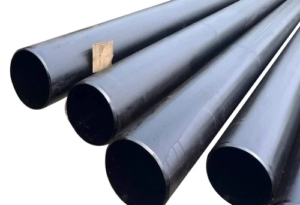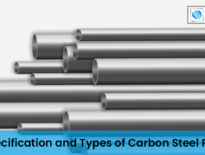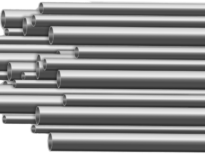Carbon steel pipe & tube, also called CS pipe, are made from steel ingots or solid round steels. These are perforated into capillary tubes and then hot-rolled, cold-rolled, or cold-drawn. Due to their strength and pressure resistance, carbon steel pipes are widely used in heavy industries like infrastructure, shipping, stills, and fertilizer equipment. These pipes are crucial in the steel pipe industry.
Types of Carbon Steel Pipes
Carbon steel can be further divided into low carbon steel, medium carbon steel and high carbon steel, mainly depending on the carbon content in the steel.
General Carbon Steel Pipe
These are made from high-quality carbon-structured steel such as 10, 20, 30, 35, and 45, and low-alloy structural steel like 16Mn and 5MnV. These pipes are used for fluid transportation and in mechanical parts manufacturing, such as automotive and tractor components.
- Mild Steel (Low Carbon Steel):
- Carbon Content: 0.04% – 0.30%
- Properties: Good ductility, toughness, easy to process and weld.
- Examples: Q195, Q215, Q235
- Medium Carbon Steel:
- Carbon Content: 0.30% – 0.60%
- Properties: High strength and hardness, lower ductility and toughness.
- Examples: 45# steel, 40Cr
- High Carbon Steel:
- Carbon Content: 0.60% – 2.00%
- Properties: High strength and hardness, lower ductility and toughness, poor weldability.
- Examples: 65Mn, T8, T10
Production Methods
- Seamless Steel Pipes: Made by hot rolling or cold drawing, offering high strength and tightness.
- Welded Steel Pipes: Created by rolling steel plates or strips into a cylindrical shape, with seams joined through resistance welding or submerged arc welding.
CS Pipe Specs and Standards
| Product Name | Executive Standard | Dimensions (mm) | Steel Grade |
| Black and hot-dip galvanized seamless steel pipe | ASTM A53 | 0.3 – 1200 x 1.0 – 150 | GR.A, GR.B, GR.C |
| High-temperature seamless carbon steel | ASTM A106 | 10.3 – 1200 x 1.0 – 150 | GR.B, GR.C |
| Seamless cold drawn mild steel heat exchanger and condenser tubes | ASTM A179 | 10.3 – 426 x 1.0 – 36 | Low-carbon steel |
| Seamless carbon steel boiler tubes for high pressure | ASTM A192 | 10.3 – 426 x 1.0 – 36 | Low-carbon steel |
| Seamless cold drawn intermediate alloy steel heat exchanger tubes | ASTM A199 | 10.3 – 426 x 1.0 – 36 | T5, T22 |
| Seamless medium carbon steel boiler and superheater tubes | ASTM A210 | 10.3 – 426 x 1.0 – 36 | A1, C |
| Seamless ferritic and austenitic alloy steel tubes | ASTM A213 | 10.3 – 426 x 1.0 – 36 | T5, T9, T11, T12, T22, T91 |
| Seamless carbon and alloy steels for mechanical tubing | ASTM A333 | 1/4″ – 42″ x SCH20 – XXS | Gr1, Gr3, Gr6 |
| Seamless and welded carbon and alloy steel pipes for cryogenic use | ASTM A334 | 1/4″ – 4″ x SCH20 – SCH80 | Gr1, Gr6 |
| Seamless cold drawn carbon steel feedwater heater tube | ASTM A556 | 10.3 – 426 x 1.0 – 36 | A2, B2 |
Advantages of Carbon Steel
- Strength and Durability: Ideal for heavy machinery and structural applications.
- Cost-Effectiveness: Less material usage due to high strength and recyclability.
- Versatility: Easy fabrication, cutting, and bending for various applications.
- Environmental Benefits: Recyclable material, reducing waste.
Applications of Carbon Steel Pipe
- Oil and Gas Industry: Reliable pipelines for transporting oil and natural gas.
- Construction: Structural components in bridges, buildings, roads, and tunnels.
- Automotive Industry: Used in exhaust pipes, frames, and chassis components.
- Mechanical Engineering: Essential in conveying systems, pressure vessels, and hydraulic systems.
- Chemical Industry: Utilized in reactors, storage tanks, and conveying systems for its corrosion and high-temperature resistance.

Application of carbon steel pipe
Carbon steel pipes are widely utilized across industries for their durability, corrosion resistance, and machining ease.
- Oil and Natural Gas Industry: Essential for pipelines, carbon steel pipes offer high strength, reliability, and corrosion resistance, ensuring safe and efficient oil and gas transmission.
- Construction and Structural Engineering: Used in bridges, high-rise buildings, roads, and tunnels, carbon steel pipes support structural loads, providing essential strength and durability.
- Automobile Manufacturing: Found in exhaust systems, frames, and chassis components, these pipes offer excellent wear resistance and strength crucial for vehicle performance.
- Mechanical Engineering: Integral in conveying systems, pressure vessels, and hydraulic components, carbon steel pipes provide robustness and reliability under demanding conditions.
- Chemical Industry: Used in conveying systems, reactors, and storage tanks, these pipes offer corrosion resistance and high-temperature endurance, critical for chemical processes.
Carbon Steel vs. Black Steel
- Corrosion Resistance: Carbon steel is prone to corrosion but can be protected by blackening.
- Applications: Black steel, with its iron oxide coating, is used in gas transport, fire sprinkler systems, and protective conduit applications.
Carbon Steel Grade Vs Carbon Content
| Grade | Carbon Content (%) |
| Ultra-high carbon steel | 1.00 – 2.00 |
| High-carbon steel | 0.60 – 0.99 |
| Medium carbon steel | 0.30 – 0.59 |
| Low-carbon steel | 0.16 – 0.29 |
| Ultra-low carbon steel | 0.05 – 0.15 |
Black steel pipe, renowned for its seamless construction, excels in gas transport due to its superior properties compared to galvanized pipe. Its designation as “black steel” stems from the iron oxide coating that forms naturally on its surface during manufacturing.
The robustness of black steel pipe makes it highly suitable for diverse applications. It is extensively used in both rural and urban settings for conveying water and natural gas, as well as for protecting electrical wiring and conduits carrying high-pressure steam and air. In the oil industry, black steel pipes efficiently transport large volumes of oil to remote locations, requiring minimal maintenance. Additionally, they find use in gas distribution within and outside homes, as well as in wells and sewage systems. It’s important to note that black steel pipes are not used for transporting drinking water due to regulatory considerations.
Conclusion
Solitaire Overseas provides a wide range of carbon steel pipes and tubes, ensuring top quality and reliability for diverse industrial applications. Whether you need seamless or welded steel pipes, our products are crafted to meet your needs, ensuring efficiency and durability in every
project.
Faq
What is carbon steel?
Carbon steel is a type of steel that primarily consists of iron and carbon, with a carbon content typically below 0.35 wt. %. It contains minimal amounts of other alloying elements, making it relatively low-cost and easy to work with, but it is prone to rust and corrosion.
What is carbon steel pipe used for?
Carbon steel pipe is used for transporting liquids, gas, and steam in both aboveground and underground applications. While it is not recommended for corrosive environments, it can be used in caustic services. Its strength and durability make it suitable for various industrial applications.
What is Carbon Steel Made Of?
Manufacturers make carbon steel from iron and carbon, with the carbon content typically ranging between 0.12% to 2.0%. Other elements might be present in small amounts to enhance certain properties, but carbon and iron are the primary components.


